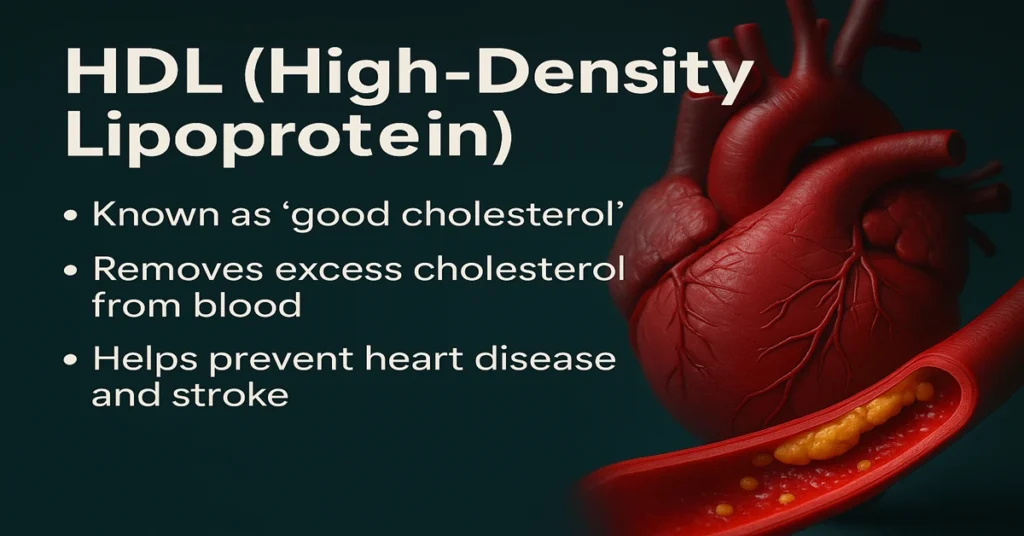What is HDL (High-Density Lipoprotein)?
HDL stands for High-Density Lipoprotein, often called the “good cholesterol.”
It plays a vital role in maintaining heart health by removing extra cholesterol from the bloodstream and carrying it back to the liver, where it is processed and removed from the body.
In simple terms, HDL works like a cleaner — it cleans up the excess cholesterol that can build up inside your blood vessels. This helps prevent blockages in arteries, reducing the risk of heart disease, heart attacks, and strokes.
Higher HDL levels are considered beneficial, while low HDL increases the risk of cardiovascular problems.
Where is HDL Produced in the Body?
HDL is naturally produced by the body, primarily in the following organs:
- Liver – Main site of HDL production
- Intestines – Also help produce HDL particles
- Body cells – Some HDL is formed using cholesterol and proteins from food and cell metabolism
Your liver and intestines combine fats and proteins to form HDL, which then circulates in your blood to remove unwanted cholesterol from arteries.
Main Functions and Importance of HDL
HDL is one of the most important components of the lipid profile test, as it helps protect your heart and arteries in several ways:
- 🧹 Removes excess cholesterol from the blood and transports it to the liver for excretion.
- 💖 Protects blood vessels by preventing plaque buildup and inflammation.
- 🧠 Reduces the risk of atherosclerosis, a condition where arteries become narrow and stiff.
- 🧪 Acts as an antioxidant, reducing oxidative stress and cell damage.
- 💪 Helps prevent blood clots by maintaining healthy vessel function.
In short, HDL keeps your arteries clean and flexible, ensuring smooth blood flow and better heart function.
Causes of Low HDL Levels (Low “Good Cholesterol”)
Low HDL levels (also known as Hypoalphalipoproteinemia) can increase your risk of heart disease because cholesterol starts accumulating inside blood vessels.
Common Causes Include:
- Lack of physical activity or exercise
- Smoking (reduces HDL production and function)
- Obesity or high body fat
- Uncontrolled diabetes
- High carbohydrate or processed food diet
- Genetic lipid disorders
- Certain medications such as beta-blockers, anabolic steroids, or diuretics
Symptoms of Low HDL
Low HDL doesn’t cause direct symptoms, but over time it contributes to:
- Heart disease and chest pain (angina)
- Stroke risk
- Atherosclerosis (fat accumulation in arteries)
That’s why it’s important to check HDL as part of your routine lipid profile test, even if you feel healthy.
Causes of High HDL Levels
In general, higher HDL levels are a good sign, especially if achieved naturally.
However, very high HDL (>100 mg/dL) may sometimes occur due to rare genetic conditions and might not always be protective.
Common Causes of High HDL:
- Regular exercise and active lifestyle
- Healthy fats in diet (omega-3 fatty acids, olive oil, nuts, avocado)
- Moderate alcohol intake (occasional small amounts)
- Certain medications or genetic factors
Symptoms of High HDL
Usually, there are no symptoms of high HDL.
It’s often detected during a lipid profile test.
In rare genetic conditions where HDL is extremely high, doctors may evaluate other related cholesterol parameters.
Reference Ranges (Normal Values)
| HDL Level | Category | Risk Indication |
|---|---|---|
| < 40 mg/dL (Men) | Low | High heart disease risk |
| < 50 mg/dL (Women) | Low | High heart disease risk |
| 40 – 59 mg/dL | Borderline | Acceptable |
| ≥ 60 mg/dL | High | Protective & Ideal |
A higher HDL level (>60 mg/dL) helps protect against heart disease, even if LDL is slightly high.
Sample Type
Sample Type: Serum
Tube Used: Red Top (Plain Tube)
Fasting Required: Usually 9–12 hours before a lipid profile test
Test Preparation
To get accurate HDL test results:
- Fast for 9–12 hours before the test (only water allowed).
- Avoid alcohol and high-fat meals for at least 24 hours before testing.
- Discuss any ongoing medications with your doctor.
- Maintain your regular diet and physical activity before testing.
When to Consult a Doctor
You should talk to your doctor if:
- Your HDL level is below 40 mg/dL (men) or below 50 mg/dL (women)
- You have a family history of heart disease or stroke
- You are overweight or diabetic
- You experience chest pain, fatigue, or shortness of breath
- Your lipid profile shows high LDL or triglycerides
Your doctor may suggest lifestyle changes, diet modification, or medication depending on your overall cholesterol balance.
Important Word Explanations
| Term | Meaning |
|---|---|
| Cholesterol | A waxy substance needed for cell function but harmful in excess. |
| Atherosclerosis | Hardening or narrowing of arteries due to fat buildup. |
| Lipoprotein | A molecule made of fat and protein that transports cholesterol. |
| Antioxidant | Substance that protects cells from damage caused by free radicals. |
| Lipid Profile Test | A group of tests measuring total cholesterol, HDL, LDL, and triglycerides. |
~END~

